Free real estate letter of intent template
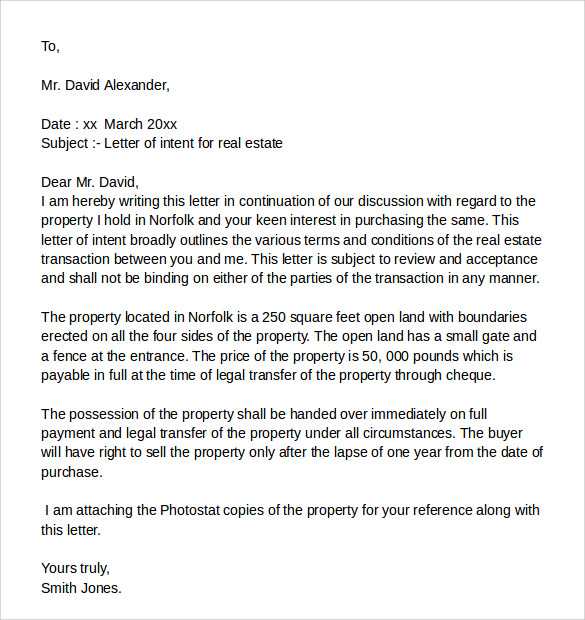
If you’re planning to enter into a real estate deal, having a clear and concise letter of intent (LOI) is a smart move. This document sets the stage for the formal agreement, ensuring both parties understand the basic terms before making a full commitment. With the right template, you can save time while ensuring all necessary elements are included.
The Letter of Intent acts as a preliminary agreement outlining the key terms and conditions for a potential transaction. It is not legally binding, but it provides a framework that makes negotiations smoother. A well-structured LOI covers the property details, price, financing arrangements, and any contingencies or deadlines involved in the process.
By using a free real estate LOI template, you ensure you don’t miss critical elements in the document. The template helps you customize the content to match your specific deal while saving you from starting from scratch. It’s a great tool for both buyers and sellers, simplifying the drafting process while keeping you focused on the key details that matter most.
Here’s an improved version:
Make your Letter of Intent (LOI) clear and concise. Start with the names of the parties involved, followed by a description of the real estate property, including the address and legal description if available. Specify the intended purpose of the transaction, whether it’s for lease, sale, or development.
Key Details to Include
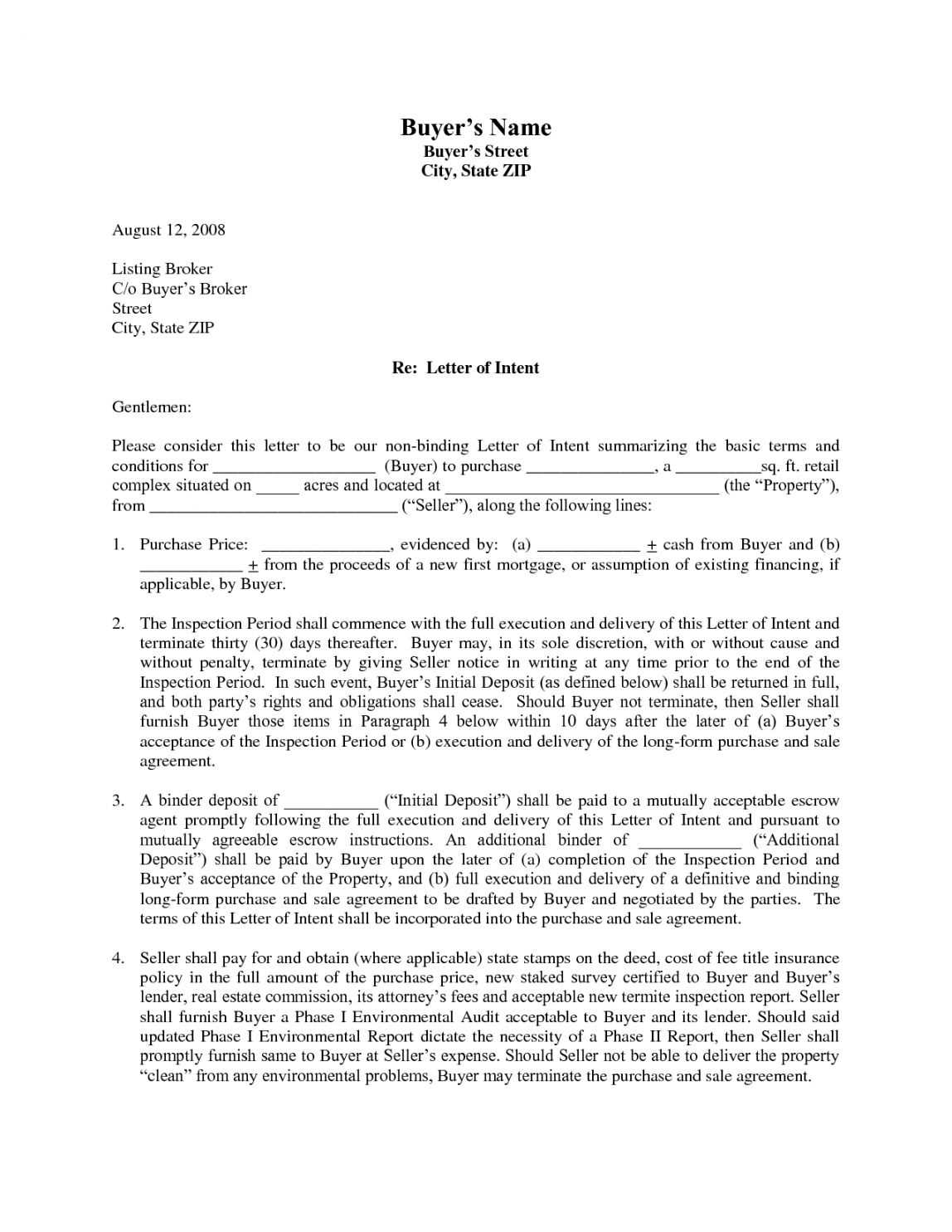
State the purchase or rental price, the payment schedule, and any contingencies that may apply. Address the timeline for finalizing the deal, such as the due diligence period, closing date, or other critical milestones. Clarify any obligations for both parties, such as property inspections, financing approval, or zoning requirements.
Closing the Deal
End with the signatures of both parties, indicating their intent to move forward with the agreement. Leave space for further negotiation but make sure both sides are aligned on the primary terms before proceeding.
- Free Real Estate Letter of Intent Template
When drafting a letter of intent (LOI) for a real estate transaction, clarity and precision are key. The LOI sets the stage for negotiations and serves as a formal expression of interest in a property. Below is a basic template to help guide you through the process.
Letter of Intent Template
Letter of Intent
Date: [Insert Date]
To: [Insert Recipient Name and Address]
Re: Letter of Intent for Real Estate Transaction
Dear [Insert Recipient Name],
This letter serves as an expression of interest in leasing/purchasing the property located at [Insert Property Address]. The purpose of this LOI is to outline the preliminary terms and conditions for further negotiation between both parties.
Key Terms
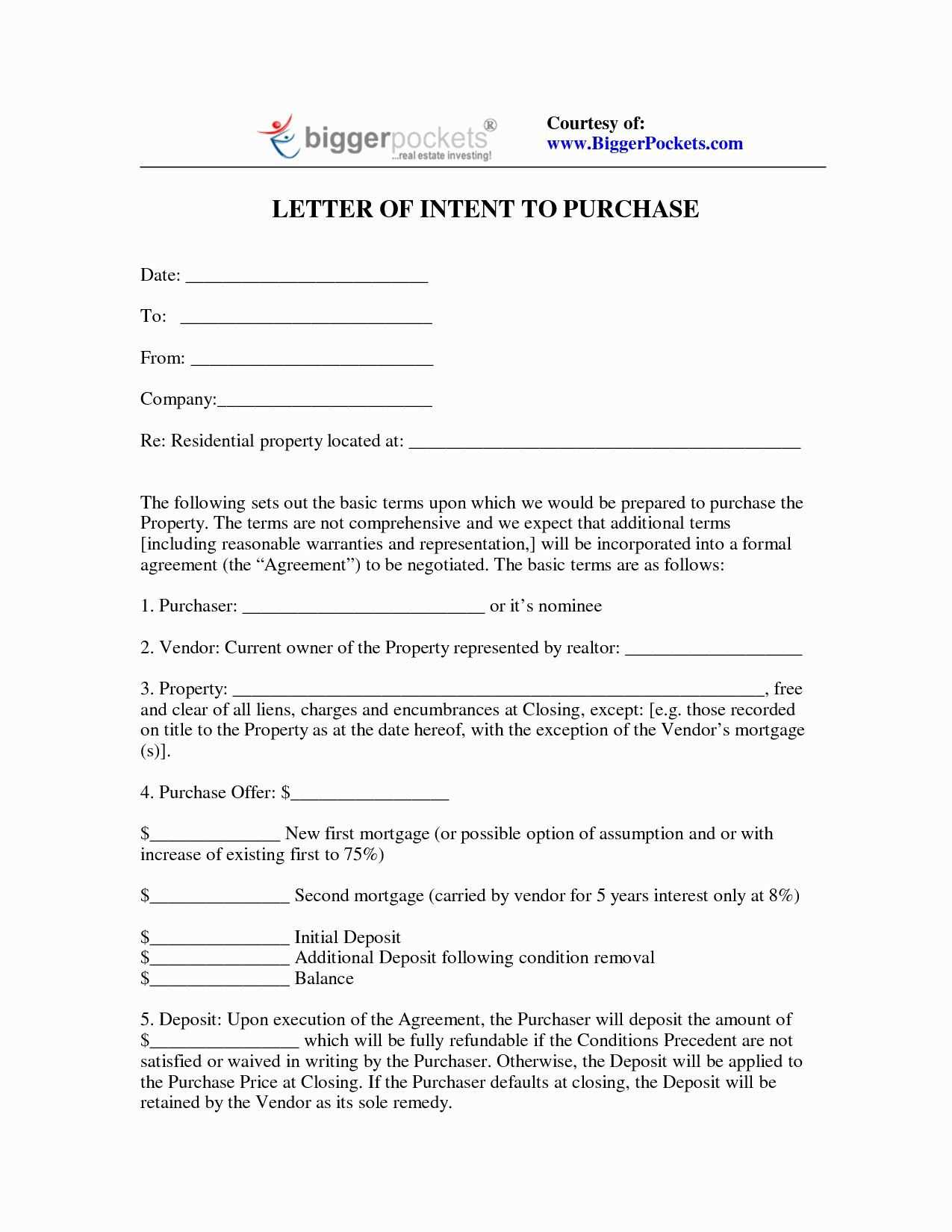
- Property: [Provide property description or details]
- Price/Lease Terms: [Insert proposed price or lease rate]
- Term Length: [Insert lease term or expected purchase timeline]
- Deposit: [Indicate any proposed deposit amount]
- Contingencies: [List any contingencies such as inspections, financing, or zoning approvals]
This letter outlines the basic terms for your consideration. It does not constitute a binding agreement but is intended to serve as a starting point for further discussions. If the terms outlined are agreeable, we are ready to move forward with a formal agreement.
We look forward to your response and the opportunity to negotiate a mutually beneficial arrangement.
Sincerely,
[Insert Your Name]
[Insert Your Contact Information]
Adjust the template to reflect the specific terms of your transaction. Start by replacing placeholders like “Buyer” and “Seller” with the names of the actual parties involved. This ensures clarity in identifying all involved stakeholders.
Next, input accurate property details, such as the full address, legal description, and unique identifiers. These specifics are crucial to avoid misunderstandings later on.
Modify the terms of the offer to align with your negotiation. If you’re agreeing on an initial deposit or adjusting the purchase price, make sure to update these fields accordingly. Be clear about any contingencies, such as financing, inspections, or other conditions that may affect the agreement.
Review any dates and deadlines within the document. Adjust these to reflect your timeline, whether it’s for an inspection, closing, or other critical milestones. Missing a deadline can lead to confusion or contract disputes.
Include any specific terms unique to the deal. If you’re offering seller concessions or agreeing to special repairs, ensure those are clearly outlined within the document.
Lastly, check that the signing parties are correctly named and their signatures are placed in the appropriate section of the document. It’s a good idea to add a line for any amendments or additional agreements, should they arise during the negotiation process.
Clearly outline the parties involved at the beginning of the letter. Specify the names of the buyer, seller, or landlord, and the intended parties in the transaction.
- Property Description: Provide an accurate and detailed description of the property. Include address, size, and any specific features that are key to the transaction.
- Transaction Terms: Outline the proposed purchase price, rent, or lease terms, along with any conditions related to financing, inspection, or contingencies.
- Closing or Lease Date: State the expected timeline for closing the deal or the commencement of the lease. Specify deadlines for due diligence or property inspections.
- Deposit or Earnest Money: Specify the amount of any deposits or earnest money, including how it will be held and conditions for its return.
- Contingencies: Include any conditions that must be met for the transaction to proceed, such as inspections, financing approval, or zoning verification.
- Confidentiality and Exclusivity Clauses: Indicate any confidentiality agreements or exclusivity terms that apply to the negotiation process.
- Termination Clause: Define the conditions under which either party can terminate the agreement, including any penalties or forfeitures involved.
- Signatures: Conclude the letter with space for both parties to sign, indicating their acknowledgment and intent to proceed based on the terms outlined.
Common Mistakes to Avoid When Drafting an LOI
- Being Too Vague: Clarity is key. Avoid using broad or unclear terms. Specify important details like timelines, terms, and conditions to prevent misinterpretations later.
- Failing to Address Key Terms: An LOI should outline fundamental aspects such as rent, lease duration, and payment terms. Neglecting to mention these details may lead to confusion or disagreements.
- Overcomplicating the Language: Keep the language simple and straightforward. Legal jargon can obscure the meaning and complicate negotiations. Focus on plain language that is easy to understand.
- Missing Contingencies: Always include contingencies for necessary approvals or inspections. Failing to do so may result in missed opportunities to back out or renegotiate if circumstances change.
- Ignoring the Non-Binding Nature: Remember, an LOI is typically non-binding. Do not present it as a final agreement unless it is intended to be legally binding. Make sure all parties understand this distinction.
- Leaving Out Dispute Resolution Terms: Always specify how disputes will be handled. Whether through mediation or arbitration, clearly define the process to avoid lengthy legal battles later.
- Not Accounting for Deadlines: Be sure to set deadlines for responses and actions. This keeps negotiations on track and avoids unnecessary delays.
Begin by clearly defining key terms, such as the purchase price, timeline, and contingencies. This ensures both parties are on the same page from the outset. Be specific about deadlines and expectations to avoid future disputes.
Next, focus on flexibility. Allow for adjustments if new information arises, but set clear limits. This helps prevent misunderstandings and ensures that both sides feel their concerns are addressed.
Use precise language to outline any due diligence periods. Specify how long each party has to review necessary documents and conduct inspections. Clearly stating these time frames helps to avoid any delays or miscommunications later in the process.
It’s crucial to include termination clauses. These clauses protect both parties in case the transaction falls through due to unforeseen issues. Specify the conditions under which the letter of intent can be terminated, as well as any penalties or obligations associated with the termination.
Lastly, aim for balance. Ensure that the terms are fair and mutually beneficial. Consider future implications for both parties to ensure the agreement stands up under scrutiny.
Make sure to clearly define the terms of the agreement in the LOI. This includes specifying the responsibilities, timelines, and any contingencies related to the deal. Ambiguity in the letter could lead to misunderstandings, creating unnecessary legal risks.
Binding vs Non-Binding Provisions
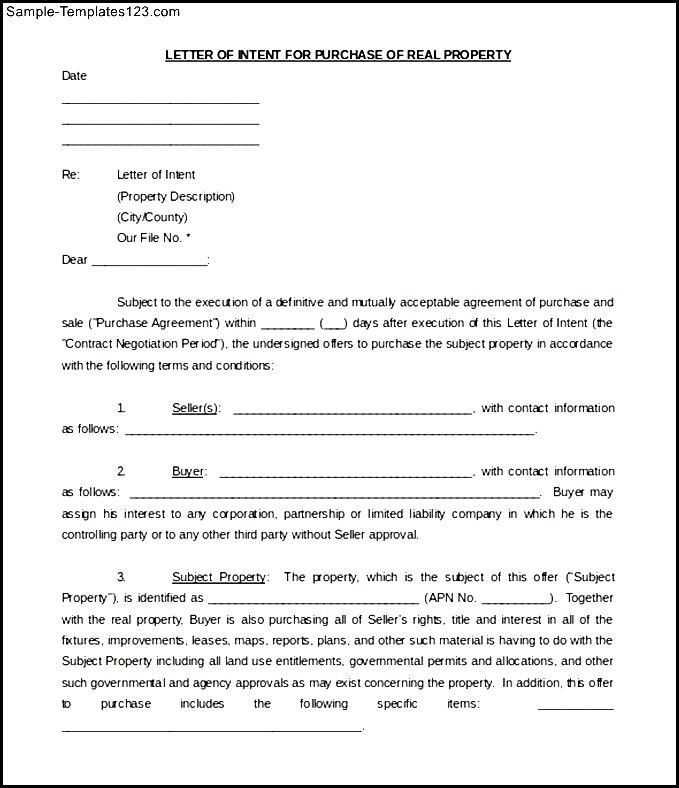
Decide which sections of the LOI will be legally binding and which ones will not. Typically, an LOI is non-binding, but certain clauses, such as confidentiality and exclusivity, can be made enforceable. Without clear distinctions, you may face challenges if a dispute arises over what was intended to be binding.
Compliance with Local Laws
Ensure that your LOI adheres to local laws and regulations. Real estate laws vary by jurisdiction, and failing to comply could result in the letter being invalid or unenforceable. Review the LOI with a legal expert familiar with the real estate laws of the relevant area.
Protect yourself by including dispute resolution clauses in the LOI. Specify the method for resolving disagreements, such as mediation or arbitration, to avoid costly court battles. This helps streamline the process and reduces the potential for prolonged legal disputes.
By addressing these legal aspects in your LOI, you reduce risk and improve the clarity of your real estate transactions.
To convert a letter of intent (LOI) into a binding agreement, both parties must clearly outline the specific terms that will govern their relationship. Start by identifying and finalizing the key elements, such as price, timelines, and responsibilities. Ensure these details are incorporated into the LOI before moving forward.
Once the LOI is drafted, both parties should engage in negotiations to confirm the terms. At this stage, consult legal professionals to review the document and ensure it aligns with your goals. A legally enforceable contract requires that both parties demonstrate mutual consent and intent to be bound by the terms. If needed, revise the LOI based on legal advice and negotiations.
To formally transition the LOI into a binding contract, both parties must sign the document with the clear intention of creating legal obligations. Adding clauses regarding dispute resolution and jurisdiction ensures the agreement is enforceable under the law. After signing, the LOI becomes a binding contract, subject to the agreed-upon conditions.
Revised Structure for Clarity
Adjusting the construction of your real estate letter of intent can help eliminate repetitive language while preserving its original meaning. Focus on streamlining the message to ensure clear communication without redundancy.
How to Rework the Content
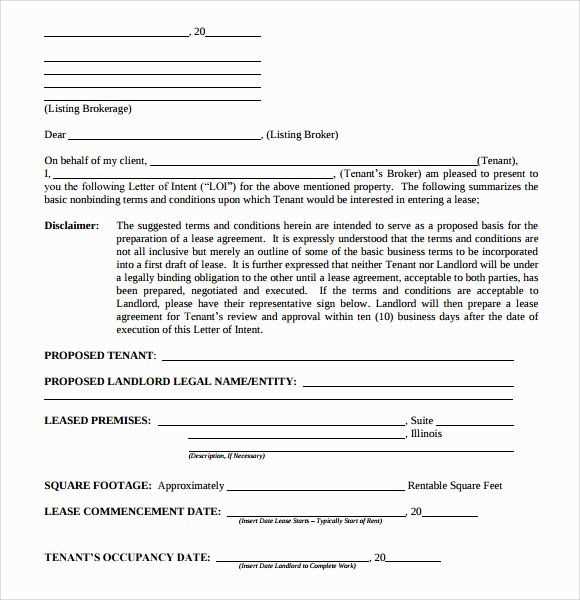
Begin by eliminating unnecessary phrases and condensing lengthy sentences. For example, instead of repeating terms like “mutually agreed upon” or “in both parties’ best interests,” simplify the sentence structure and convey the message in fewer words. Consider rephrasing sections to convey the same intent in a more direct manner.
Table of Comparison: Original vs. Revised Structure
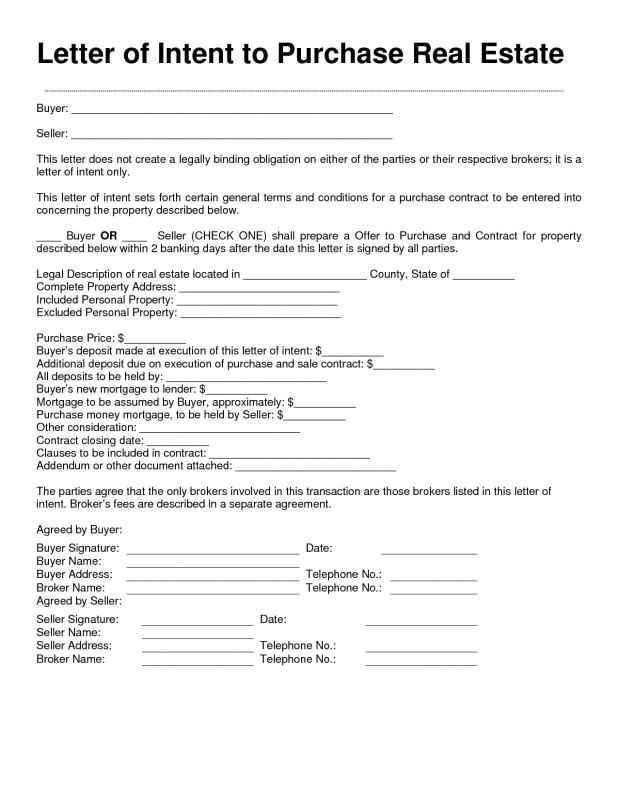
| Original Phrase | Revised Phrase |
|---|---|
| “Both parties mutually agree on…” | “Both parties agree on…” |
| “In the event that both parties are in agreement…” | “If both parties agree…” |
| “At the earliest convenience of both parties involved…” | “As soon as both parties are ready…” |
By trimming down unnecessary phrases, you can maintain a concise tone while ensuring the letter of intent remains professional and clear. This not only improves readability but also makes the document more direct and actionable.